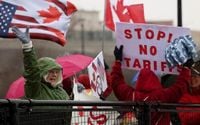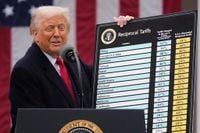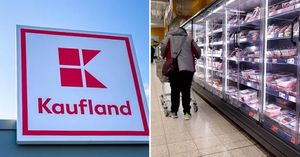In a dramatic escalation of trade tensions, President Donald Trump unveiled a sweeping new tariff plan on April 2, 2025, which he dubbed "Liberation Day." The announcement, made during a Rose Garden event, included a baseline tariff of 10% on all imports to the United States, set to take effect on April 5, 2025. The plan also outlines additional tariffs targeting specific countries deemed as "bad actors," including a staggering 34% tariff on Chinese imports, which will raise the total tariff on China to 54% when the new rates are implemented on April 9.
Trump's announcement has sent shockwaves through global markets, with the Dow Jones Industrial Average plunging approximately 1,260 points, or 3%, shortly after the news broke. The S&P 500 and Nasdaq followed suit, dropping 3.1% and over 4% respectively. Asian markets were not spared, as Japan's Nikkei 225 index fell 2.7% to its lowest level since August.
The tariffs are part of a broader strategy aimed at addressing trade deficits with various nations. The Trump administration calculated these tariffs based on the trade deficit with each country, which they claim reflects unfair trade practices. A senior administration official stated that the calculation aims to drive the trade deficit "back towards zero," a goal that reflects Trump's long-standing focus on trade balances.
European Commission President Ursula von der Leyen responded swiftly, indicating that the EU is finalizing a package of countermeasures to protect its interests in light of the new tariffs. "We are now preparing for further countermeasures to protect our interests and our businesses if negotiations fail," she warned, emphasizing the EU's readiness to respond decisively.
China's commerce ministry also expressed strong opposition, stating they would take countermeasures to safeguard their rights and interests following the imposition of the 34% tariff. Prime Minister Mark Carney of Canada pledged that the country would "fight these tariffs with countermeasures," while Mexican President Claudia Sheinbaum announced plans for a comprehensive program, avoiding a direct "tit-for-tat" response.
While Canada and Mexico were notably absent from the list of countries facing the new baseline tariff, they are not exempt from existing tariffs that have already been imposed. The recent Senate vote, which passed legislation to terminate new tariffs on Canada, represents a rare rebuke of Trump from within his own party. The Republican-controlled Senate voted 51-48 to approve the bill, which will likely be blocked in the House of Representatives.
The proposed tariffs have raised concerns among U.S. lawmakers, particularly those from agricultural states. Senator John Thune, the Republican majority leader, acknowledged the potential harm retaliatory tariffs could pose to local industries. He expressed discomfort with any "across the board tariffs," highlighting the delicate balance lawmakers must strike between supporting the president’s agenda and protecting their constituents.
In the tech sector, companies like Apple and Nvidia have already begun to feel the impact of the new tariffs. Apple's shares fell nearly 7% in after-hours trading, reflecting investor anxiety over the potential cost implications of the tariffs. Apple's overseas production, particularly in China, Vietnam, and India, places it at significant risk under the new tariff regime.
Adding to the complexity, Trump confirmed that a secondary tariff would be imposed on countries purchasing oil or gas from Venezuela, setting a 25% tariff for these transactions. This move is part of a broader effort to leverage tariffs as a tool for foreign policy, particularly in regions where the U.S. seeks to exert influence.
The Yale Budget Lab has projected that a broad 20% tariff could raise consumer prices by an estimated 2.1% if no countries retaliate, and by 2.6% if they do. This could result in an annual loss of $3,400 to $4,200 per household, along with a potential GDP growth hit of 0.9% to 1% in 2025.
Despite the backlash, Trump touted significant domestic investments from major tech companies, claiming that the tariffs would encourage them to build more facilities in the U.S. He highlighted Apple's commitment to invest $500 billion over the next four years, alongside similar pledges from other companies like Nvidia and TSMC.
As the trade landscape shifts, experts are warning that the economic ramifications of Trump's tariffs could lead to a recession if retaliatory measures escalate. The uncertainty surrounding these tariffs is already causing disruptions in the manufacturing sector, with reports indicating a slowdown in activity as companies brace for the financial impact of increased costs.
Looking ahead, the next deadlines to watch are April 5 and April 9, when the baseline tariffs and individualized higher tariffs will take effect, respectively. Investors and consumers alike are left to navigate the implications of these sweeping trade policies, as the global economy braces for a potentially tumultuous period.
In summary, President Trump's "Liberation Day" tariffs mark a significant shift in U.S. trade policy, with far-reaching implications for domestic and international markets. As countries prepare their responses, the economic landscape remains uncertain, with potential repercussions for consumers and businesses across the globe.





